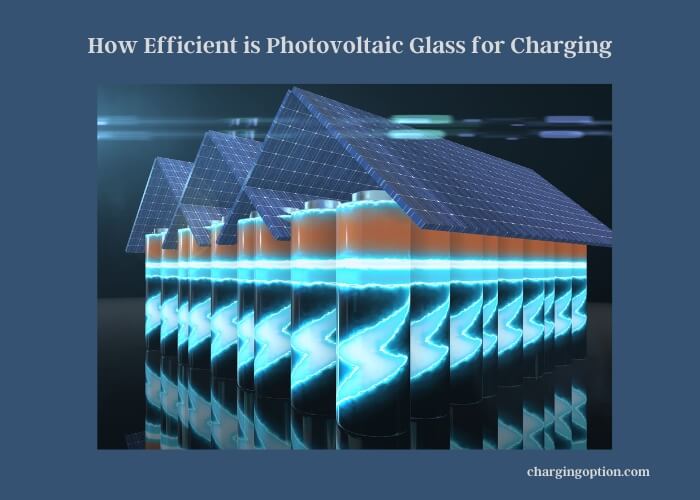Sunshine is bountiful, renewable, and can be transformed into electricity. But, the burning question is, How efficient is photovoltaic glass for charging? This article explores this hot topic, delving into the technological intricacies, its practical applications, and the challenges faced.

How Efficient is Photovoltaic Glass for Charging
Photovoltaic glass, or solar glass, is a technology that transforms sunlight into electricity. The question isn’t whether it works, it’s more about how well it works. The answer, simply put, is quite efficient. Yet, the efficiency of photovoltaic glass is a topic that needs a bit of unravelling.
What’s Under the Glass?
Photovoltaic glass is created by embedding photovoltaic cells (also known as solar cells) into the glass panels. These cells contain semiconductor materials, typically silicon, which are responsible for converting sunlight into electricity.
The Conversion Process
When sunlight hits the silicon cells, electrons get excited and begin to move, creating a flow of electric current. This process is called the photovoltaic effect, which is where photovoltaic glass gets its name.
So, What About the Efficiency?
Photovoltaic glass’s efficiency hinges on several factors: the quality of the solar cells, the intensity and angle of the sunlight, and the temperature of the cells. Typically, solar panels offer an efficiency range between 15-20%. Photovoltaic glass, being a newer technology, may currently yield slightly lower figures, but advances in technology are rapidly bridging this gap.
Applications of Photovoltaic Glass
Photovoltaic glass isn’t just about efficiency; its versatility in applications is equally impressive.
In Buildings and Architecture
One of the prime applications of photovoltaic glass is in the architecture industry. Integrated into windows, facades, and rooftops, photovoltaic glass turns buildings into mini power plants, producing green electricity while reducing energy costs.
In the Automotive Industry
Have you ever dreamed of a car that charges itself while you drive? Photovoltaic glass makes it possible. With solar panels incorporated into the vehicle’s sunroof or body, you can tap into solar energy on the go.
In the Tech Industry
From solar-powered phone chargers to outdoor Wi-Fi hotspots, photovoltaic glass is making tech gadgets more sustainable.
The Benefits and Challenges of Photovoltaic Glass
Photovoltaic glass for charging presents a mixed bag of benefits and challenges. Let’s look at both sides of the coin.
Benefits: Why Photovoltaic Glass is a Game-Changer
Apart from its ability to produce renewable energy, photovoltaic glass has several other benefits. It’s environmentally friendly, reduces energy costs, and provides a certain degree of thermal insulation.
Challenges: The Roadblocks to Photovoltaic Glass Efficiency
On the flip side, photovoltaic glass is a relatively new technology, and it faces several challenges. These include lower efficiency rates compared to traditional solar panels, the initial costs of installation, and the need for direct sunlight for optimal performance.
The Future of Photovoltaic Glass
What does the future hold for photovoltaic glass?
Advances in Technology
As technology evolves, we’re likely to see significant improvements in the efficiency of photovoltaic glass. Enhanced cell design and improved manufacturing processes are on the horizon.
Expanding Applications
With the growing demand for renewable energy sources, the applications of photovoltaic glass will only increase. Expect to see this technology in more buildings, vehicles, and everyday devices in the coming years.
Riding the Green Wave
As the world seeks to reduce carbon emissions and combat climate change, photovoltaic glass is positioned to ride the green wave. It embodies the promise of sustainability and efficiency, making it an essential player in our renewable energy future.
FAQs About Photovoltaic Glass
How does photovoltaic glass work?
Photovoltaic glass works by converting sunlight into electricity through embedded solar cells made from semiconductor materials like silicon. When sunlight hits these cells, it excites electrons, leading to the flow of electric current.
Is photovoltaic glass as efficient as traditional solar panels?
As of now, photovoltaic glass may not be as efficient as traditional solar panels, which typically offer an efficiency range of 15-20%. However, technological advancements are expected to boost the efficiency of photovoltaic glass in the near future.
What are the benefits of using photovoltaic glass?
The benefits of photovoltaic glass include the production of renewable energy, reduced energy costs, environmental friendliness, and a certain degree of thermal insulation.
What are the challenges of using photovoltaic glass?
Challenges associated with photovoltaic glass include lower efficiency rates compared to traditional solar panels, high initial installation costs, and the requirement for direct sunlight for optimal performance.
Can photovoltaic glass be used in cars?
Yes, photovoltaic glass can be used in cars. With solar panels incorporated into the vehicle’s sunroof or body, cars can harness solar energy on the move.
What is the future of photovoltaic glass?
The future of photovoltaic glass looks bright with advances in technology expected to improve its efficiency. As the demand for renewable energy sources grows, photovoltaic glass is likely to be integrated into more buildings, vehicles, and everyday devices.
Conclusion
So, to answer the question: How efficient is photovoltaic glass for charging? While it may not be as efficient as traditional solar panels at present, it shows immense promise. With its wide array of applications and potential for growth, photovoltaic glass is a shining beacon in the sustainable energy landscape.
Read more:
